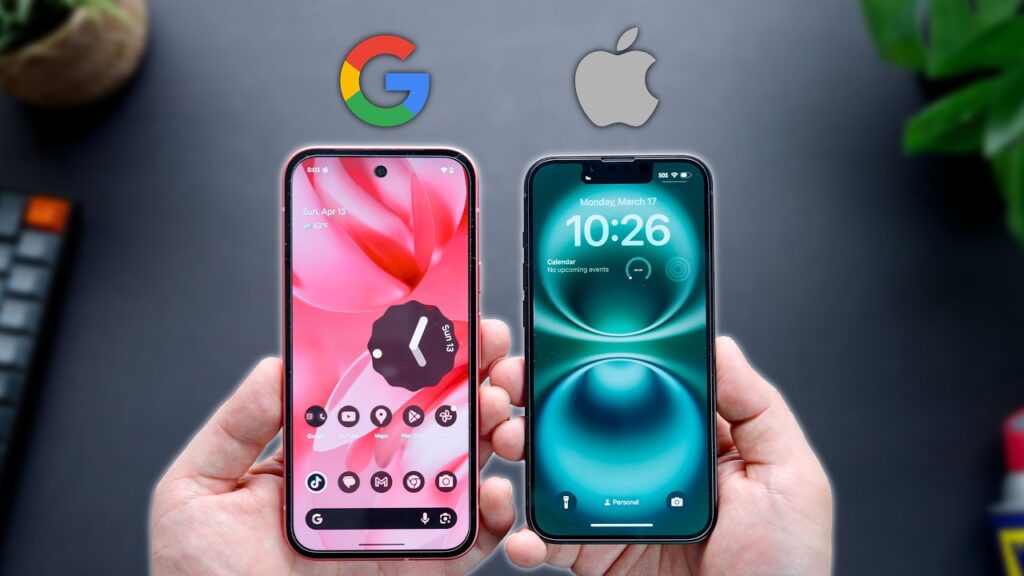The race for the best midrange flagship is heating up with two strong contenders stepping into the spotlight: the Apple iPhone 16e and the Google Pixel 9a. Both phones promise powerful features at relatively accessible prices — $600 for the iPhone 16e and $500 for the Pixel 9a. But while they may sit in the same price bracket, their approach to performance, design, and user experience differs significantly. Here’s a head-to-head comparison to help you decide which compact powerhouse suits you best.
Design & Build Quality
The iPhone 16e continues Apple’s minimalist design philosophy with a familiar aluminum frame and a glossy glass back. It keeps things simple with a single 48 MP rear camera and a traditional notch, omitting newer design elements like the Dynamic Island. It’s clean, solid, and unmistakably Apple.

In contrast, the Pixel 9a opts for a more modern look with a flat aluminum frame and a frosted plastic back that feels premium despite the lower price. Google has redesigned the camera bar into a more compact, pill-shaped bump, giving the phone a refreshed identity. Though it loses some of the classic Pixel aesthetics, it still manages to look and feel flagship-worthy.
Both phones come with IP68 water and dust resistance, ensuring durability. But the Pixel 9a edges ahead with a smoother 120Hz refresh rate display, offering a more responsive feel compared to the iPhone’s 60Hz panel.
Display: Smoothness vs Sharpness
The Pixel 9a sports a 6.3-inch OLED display, slightly larger than the iPhone 16e’s 6.1-inch screen. Google’s new Actua Display pushes brightness to a stunning 2,700 nits, which makes it more visible under direct sunlight. In comparison, the iPhone peaks at 1,200 nits.
Despite its lower refresh rate, the iPhone 16e delivers sharper visuals thanks to its higher pixel density (457 PPI vs the Pixel’s 420 PPI). That said, users who prioritize smooth scrolling and gaming will likely appreciate the Pixel’s 120Hz refresh rate more.
Performance & Software Experience
Under the hood, the iPhone 16e packs Apple’s powerful A18 chip, backed by 8GB of RAM. It outperforms the Pixel 9a in CPU and GPU benchmarks, making it the better option for high-performance tasks like video editing and demanding games.
However, the Pixel 9a is no slouch. Its custom Tensor G4 chip, while less powerful on paper, is optimized for Google’s AI features and camera processing. It handles everyday multitasking with ease and excels in intelligent photo editing, voice typing, and contextual suggestions.
Software-wise, the iPhone 16e runs iOS with tight ecosystem integration, while the Pixel 9a delivers a clean Android experience with exclusive Google features and faster updates.
Camera Capabilities
Apple sticks with a single 48 MP rear camera on the iPhone 16e, relying on advanced image processing and digital zoom to get the job done. Despite lacking an ultra-wide lens, it delivers consistent and sharp results, especially in well-lit conditions.
The Pixel 9a offers more versatility with a dual-camera setup: a 48 MP main sensor and a 13 MP ultra-wide lens. This gives users more creative freedom when shooting landscapes or group photos. However, Pixel’s image processing can sometimes overexpose selfies, which might not appeal to everyone.
Overall, the Pixel 9a offers more flexibility, but Apple maintains a lead in color accuracy and video performance.
Battery Life & Charging
The Pixel 9a includes a substantial 5,100 mAh battery that delivers up to 19 hours of browsing, easily outlasting the iPhone 16e’s 4,005 mAh unit. For users who prioritize longevity, especially for video streaming or mobile gaming, the Pixel is the clear winner.
Charging is another area where differences emerge. The iPhone 16e supports wireless charging (up to 7.5W), though it lacks Apple’s MagSafe support. The Pixel 9a, while boasting a larger battery, does not support wireless charging at all. Wired charging on both devices remains relatively standard, with no major advantages.

Final Verdict: Which Should You Buy?
If you’re looking for unmatched processing power, deep ecosystem integration, and long-term software support, the iPhone 16e is the smarter pick. It offers a refined design, fast performance, and Apple’s signature polish.
But if you’re after a smoother display, longer battery life, a more versatile camera system, and better value for money, the Pixel 9a stands out. It brings many flagship features into an affordable package without cutting corners where it counts.
Ultimately, your choice depends on what matters more—whether it’s performance and software fluidity or display quality and camera versatility. Either way, you’re looking at two of the best mini flagships available this year.
